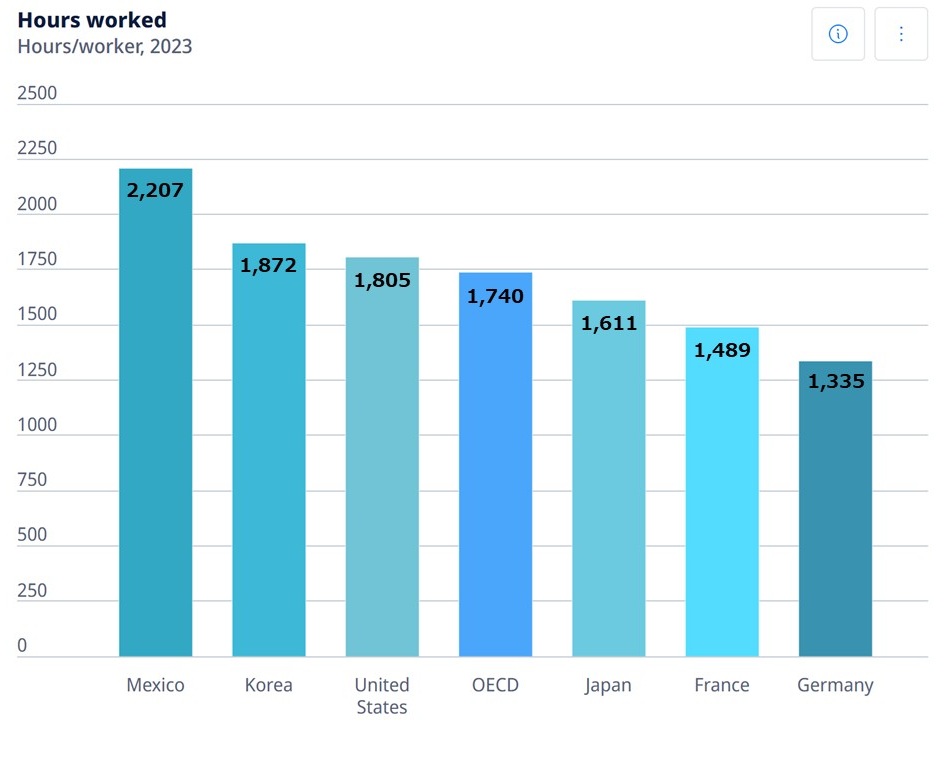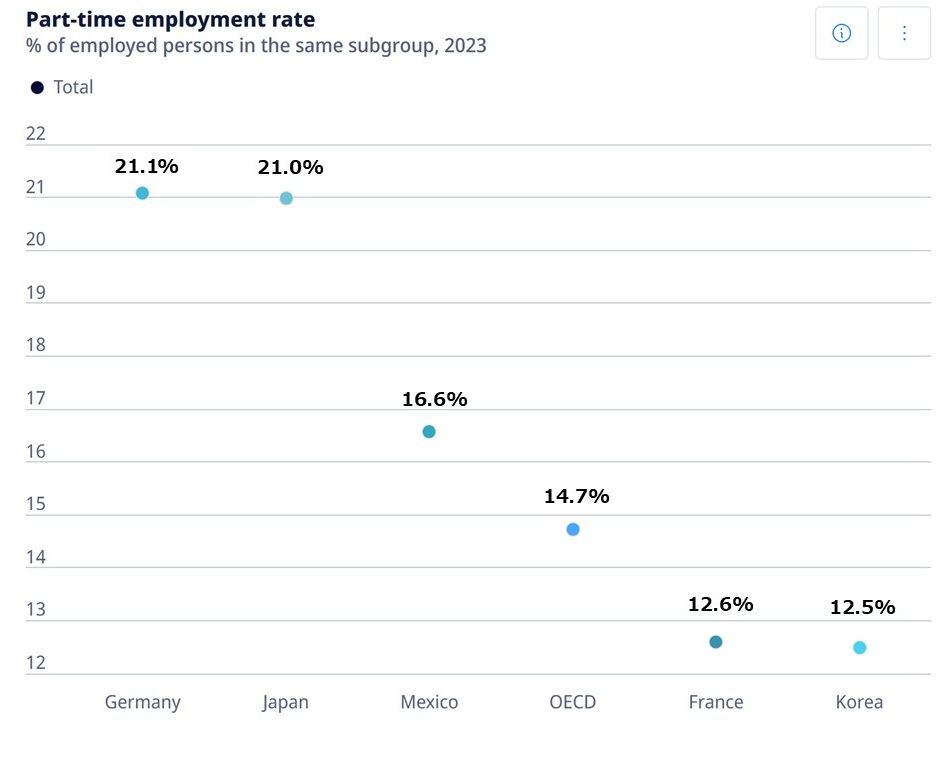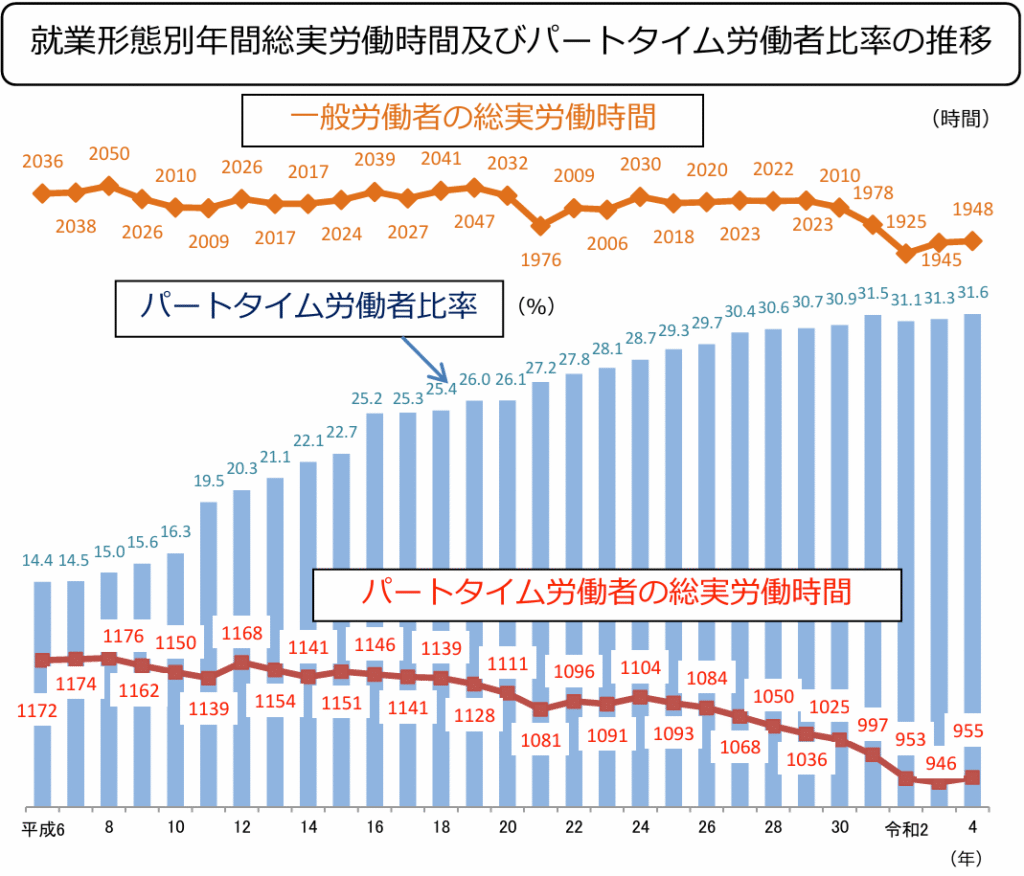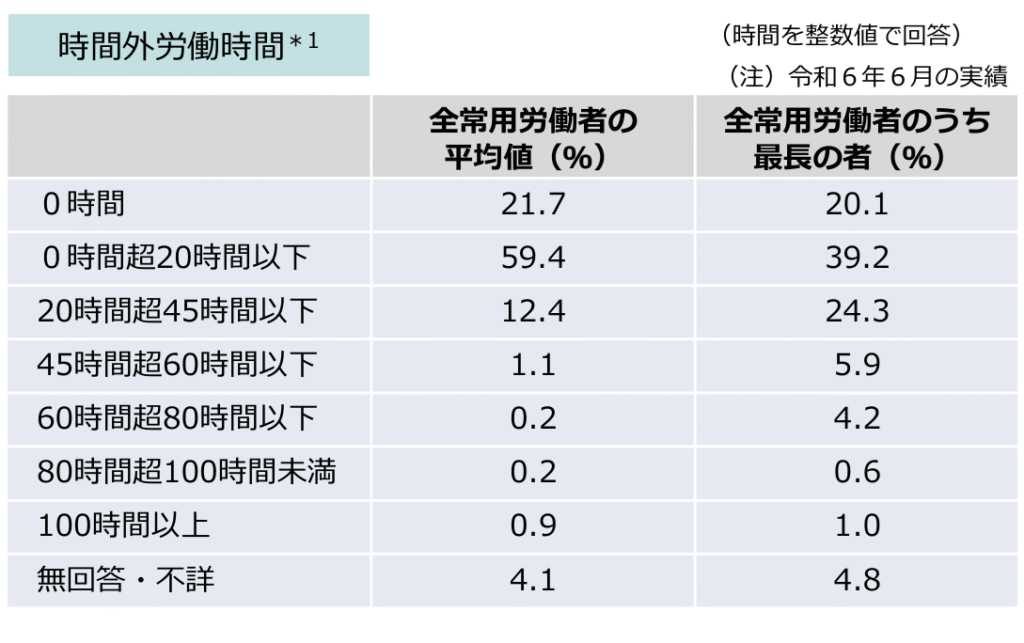Annual Working Hours in Major OECD Countries

First, let’s take a look at how many hours people in Japan actually work per year compared to other major OECD countries. (OECD data requires the collection and verification of statistics from each country, so it usually takes about 1 to 2 years before the information is reflected.) The OECD average is about 1,740 hours. Mexico, known as the country with the longest working hours, records 2,207 hours. South Korea, which is geographically close to Japan, has 1,872 hours, and the United States shows 1,805 hours, all of which are longer than the OECD average.
Japan, on the other hand, records 1,611 hours, which is shorter than those countries. France, often mentioned as a country with fewer working hours, is at 1,489 hours. Germany, whose GDP size is similar to Japan’s, shows only 1,335 hours, making it one of the lowest among OECD countries.
Interestingly, while Japan does not appear to have particularly long working hours in international comparison, it still carries a strong social image of being a “long-working-hours” society. One reason is that OECD statistics include not only full-time but also part-time workers, and because Japan has a relatively high share of part-time employment, the average tends to look lower than what many full-time workers actually experience.
Part-time Employment Rate in Major OECD Countries

Let’s look at the part-time employment rate of major OECD countries during the same period. The OECD average was about 14.7%. France (12.6%) and South Korea (12.5%) recorded lower-than-average rates. This suggests that the annual working hours data mainly reflects the reality of full-time employees.
Mexico, known as the country with the longest working hours, had a part-time employment rate of only 16.6%. In contrast, Japan (21.0%) and Germany (21.1%) showed nearly the same rate, despite having similar GDP levels. However, their annual working hours differ by about 300 hours, indicating that part-time ratios alone cannot explain the difference in working hours.
The United States is not included in this comparison, as the OECD does not provide part-time employment rate data for the country.
Japan’s Actual Working Hours, Part-time Employment Rate, and Overtime Hours

The chart above, published by Japan’s Ministry of Health, Labour and Welfare (MHLW), shows the trends in annual actual working hours by employment type and the share of part-time workers.
The orange line at the top represents the annual actual working hours of regular (non-part-time) workers. In 1994, the figure was 2,036 hours, but by 2022 it had declined to 1,948 hours—a decrease of about 100 hours over nearly 30 years. However, it is noteworthy that until as recently as 2018, the number still exceeded 2,000 hours, indicating that the decline has become more pronounced only in recent years.
The blue bars indicate the proportion of part-time workers among all employees. As is visually clear, this share has been steadily increasing, reaching 31.6% in 2022. This highlights the growing importance of part-time employment in the Japanese labor market.
The red line at the bottom shows the annual actual working hours of part-time workers. Interestingly, while the proportion of part-time workers has continued to rise, their individual annual working hours have steadily decreased. In 1994, part-time workers averaged 1,172 hours, but by 2022 the figure had fallen to 955 hours, a reduction of more than 200 hours. This indicates that even though more people are working part-time, the average working time per part-time worker has been declining.

This is overtime working hours survey data published by Japan’s Ministry of Health, Labour and Welfare (MHLW) this year. The first column shows the ranges of overtime working hours, the second column indicates the average distribution based on all workers, and the third column represents the actual distribution of all workers.
The key point of this survey is the difference between the average distribution and the actual distribution. Based on the average distribution of all regular employees, it appears that about 60% work less than 20 hours of overtime per month. However, the actual distribution shows that only about 40% fall into the under-20-hours group, while around 24% are in the 20–45 hours range. In other words, if we look only at the average, it may seem that more people work shorter hours, whereas in reality a significant proportion of workers are doing more than 20 hours of overtime per month.
The Reality of Japanese Companies as Experienced by a Foreigner
I am a Korean who has lived in Osaka and worked for about ten years, during which I experienced four different companies. Please note that my personal experiences cannot represent all Japanese companies, as they are purely individual and subjective. In addition, I have also referred to stories from people around me.
1. Most companies have overtime
From my own experience and from looking at many job postings during job hunting, I found that most companies, to a greater or lesser extent, had overtime work. Companies with no overtime at all were rare, and those often offered relatively lower salaries. I even saw a job advertisement that described “20 hours of overtime per month, good work-life balance.” Therefore, when job hunting, it is important to take such factors into consideration when choosing a company.
2. Minashi Zangyo(みなし残業)
Minashi zangyo is a system in which a company includes a fixed amount of overtime pay in the monthly salary in advance. For example, if the contract states “20 hours of minashi zangyo per month included,” the employee receives overtime pay for 20 hours even without actually working that amount.
If everyone worked overtime together or left work on time together, it might not feel problematic. However, when some employees worked overtime every day while others went home on time, it sometimes felt as if those who worked overtime were at a disadvantage. In addition, because the allowance was already included, I often felt pressured not to leave even after finishing my tasks. In some cases, supervisors even explicitly told employees to work overtime for the number of hours covered by minashi zangyo.
3. Service zangyo(サービス残業)
Service zangyo refers to unpaid overtime work. Although it is illegal by law, in reality it often occurs, such as staying after hours to prepare for meetings or write reports. Since it is not recorded, it does not appear in official statistics, yet it remains a common practice in Japanese workplace culture.
It is not a good example, but in fact I myself once continued working after clocking out at 10 p.m. during remote work because I was too busy to finish my tasks. Since overtime pay is subject to a premium after 10 p.m., the company had an unspoken rule not to work beyond that time. As a result, when things were busy, many employees secretly continued working even after clocking out. Although awareness of this issue has gradually begun to change, considering such unrecorded service zangyo, I believe that Japan’s actual working hours are even longer than the official statistics suggest.
– Recommended Reading –




Comments